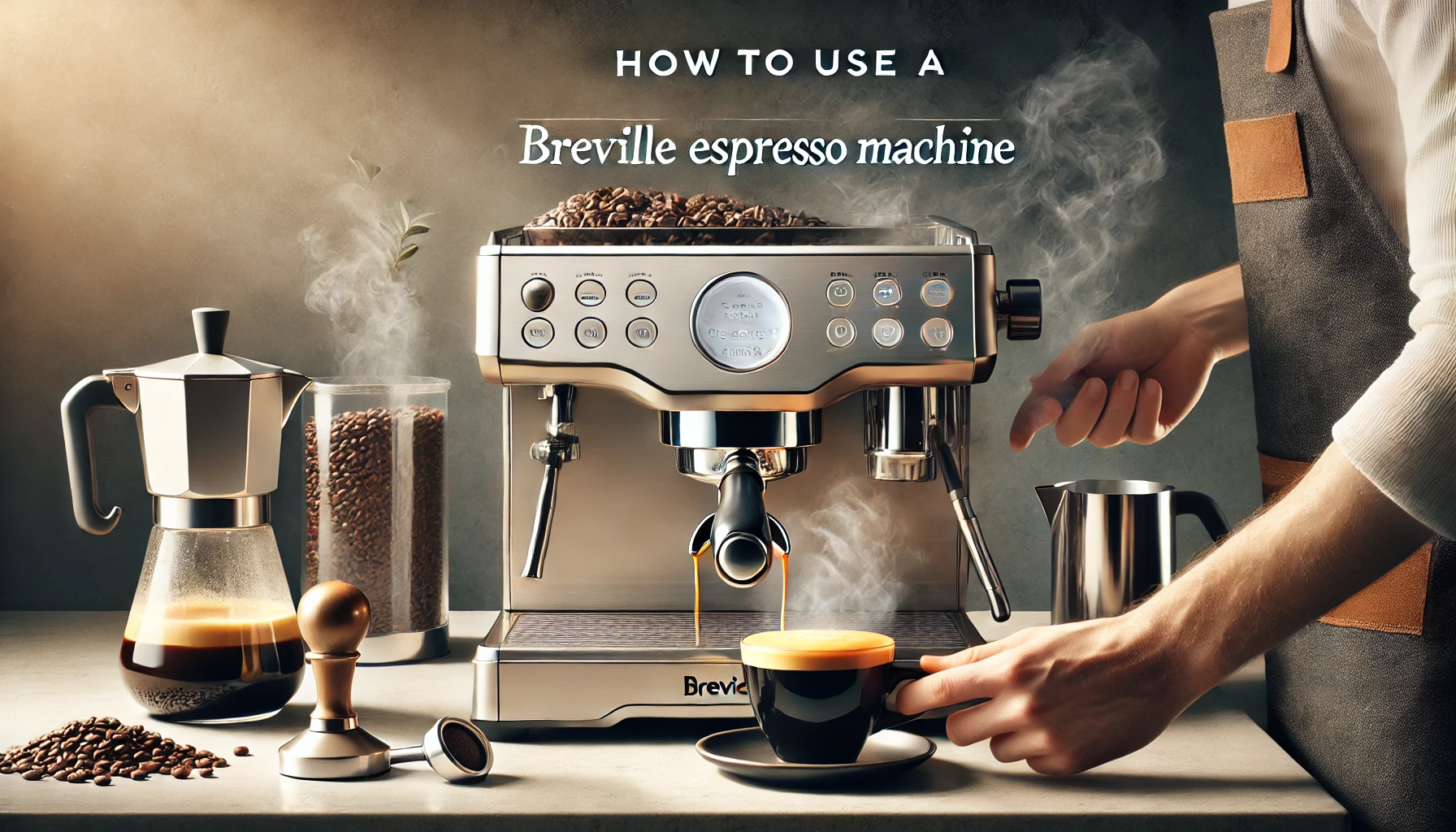There’s nothing quite like starting your morning with a rich, velvety shot of espresso. And if you own a Breville espresso machine, you’ve got everything you need to make café-quality coffee right at home. But here’s the thing—getting that perfect shot isn’t just about pressing a button.
If you’ve ever struggled with under-extracted espresso, bitter shots, or milk that just won’t froth right, don’t worry—you’re not alone. Learning to use a Breville espresso machine properly takes a bit of practice, but once you get the hang of it, you’ll never want to go back to your local coffee shop.
Step 1: Get to Know Your Breville Espresso Machine
Before we dive into the brewing process, it’s important to understand how your machine works. Breville makes several espresso models, including the Barista Express, Barista Pro, and Barista Touch, but they all have a few key components in common:
- Portafilter – This is where the magic happens. It holds your coffee grounds and locks into the machine for extraction.
- Grinder & Bean Hopper – If your model has a built-in grinder, this is where you’ll adjust your grind size for the perfect shot.
- Steam Wand – If you love lattes and cappuccinos, this tool will help you create silky microfoam.
- Pressure Gauge – Not all Breville models have this, but if yours does, it helps you track the extraction process.
- Control Panel – Buttons or dials allow you to start brewing, steaming milk, or adjusting shot volume.
Take a few minutes to familiarize yourself with your machine’s settings. Understanding how each part works will make it easier to troubleshoot problems and fine-tune your brewing skills.
Step 2: Select and Grind Your Coffee Beans
The coffee beans you choose will make or break your espresso. For the best results, always go for freshly roasted, high-quality beans. Darker roasts tend to bring out the bold, caramelized flavors espresso lovers crave, while medium roasts highlight sweet and fruity notes.
Choosing the Right Grind Size
If your espresso tastes sour and weak, your grind is too coarse. If it’s bitter and over-extracted, your grind is too fine. The ideal espresso grind should feel like fine sand—just slightly coarser than powdered sugar.
Here’s how to dial in your grind:
- Start with a medium-fine setting on your Breville grinder.
- Pull a test shot and check the extraction time—it should take around 25-30 seconds.
- Adjust as needed: If the shot is too fast, make the grind finer. If it’s too slow, make it coarser.
Using a burr grinder (like the one built into some Breville models) ensures consistent particle size, which is crucial for even extraction.
Step 3: Dosing and Tamping the Coffee Grounds
Now that you’ve got the right grind, it’s time to prepare your portafilter. This step is where a lot of home baristas go wrong, but don’t worry—I’ll walk you through it.
How to Properly Dose Your Coffee
For a single shot, aim for 8-10 grams of coffee. For a double shot, use 18-20 grams.
If your espresso isn’t extracting correctly, weighing your grounds with a precision scale can help you stay consistent.
Mastering the Tamping Technique
Tamping might seem simple, but it has a huge impact on espresso quality. If you press too hard or unevenly, your coffee will extract incorrectly.
- Hold the tamper straight and press down firmly with about 30 pounds of pressure.
- Check for an even surface—your puck should be smooth and level.
- Give the tamper a little twist at the end to polish the surface.
A well-tamped puck ensures that water flows evenly through the coffee grounds, preventing under-extraction or channeling (where water finds an easy path through gaps, ruining your shot).
Step 4: Extracting the Perfect Shot of Espresso
Now comes the fun part—pulling your espresso shot. This is where you’ll really start to see the results of all your preparation.
Steps to Pull a Perfect Shot:
- Lock the portafilter into the group head.
- Start the extraction process and watch the shot flow.
- Check the time: A proper shot should take 25-30 seconds.
- Look at the crema: A golden, velvety layer on top means you’re doing it right.
If your espresso is coming out too fast or too slow, tweak your grind size and dosing until you hit that sweet spot.
Step 5: Steaming and Frothing Milk Like a Pro
If you love lattes, cappuccinos, or flat whites, then mastering the steam wand on your Breville espresso machine is a must. The key to creating that silky, velvety microfoam is all about technique.
How to Steam Milk Properly:
- Purge the steam wand before starting to remove any condensation.
- Position the steam tip just below the surface of the milk to introduce air and create foam.
- Once you hear a gentle hissing sound, lower the pitcher slightly to allow the milk to stretch.
- Submerge the wand deeper to continue heating the milk until it reaches 140-150°F (60-65°C).
- Tap and swirl the milk to remove large bubbles and create a smooth, glossy texture.
If your milk is too foamy and bubbly, you likely introduced too much air. If it’s flat and watery, you didn’t aerate it enough. The goal is to create a silky texture that blends perfectly with your espresso.
What’s the Difference Between Cappuccino, Latte, and Flat White?
- Cappuccino has a thick layer of frothy milk.
- Latte is smoother, with more steamed milk and just a little foam.
- Flat White has microfoam but no thick froth, making it creamier.
Try experimenting with different milk types—whole milk creates the best texture, but oat milk and almond milk can also produce good results with the right technique.
Step 6: Cleaning and Maintaining Your Breville Espresso Machine
Taking care of your Breville espresso machine is just as important as making the perfect shot. A dirty machine leads to bitter coffee, clogged filters, and milk buildup in the steam wand.
Daily Maintenance:
- Flush the group head by running hot water through it after each use.
- Wipe the steam wand immediately and purge it to clear out any milk residue.
- Empty and rinse the drip tray to avoid buildup.
Weekly Deep Cleaning:
- Backflush the machine (if your model allows it) with a cleaning tablet to remove coffee oils.
- Soak the portafilter and basket in hot water to get rid of leftover grounds.
- Check the grinder for buildup and clean it if necessary.
See more: Light Roast Vs Dark Roast Coffee: Differences Between Them
Monthly Maintenance:
- Descale the machine if you have hard water. A Breville descaling solution works best.
- Replace the water filter to keep your espresso tasting fresh.
A well-maintained machine ensures consistent pressure, optimal extraction, and better-tasting coffee every time.
Troubleshooting Common Espresso Problems
Even with the best equipment, sometimes things don’t go as planned. If your espresso isn’t turning out right, don’t worry—it’s usually an easy fix.
Shot Pulling Too Fast? (Under-Extraction)
If your espresso tastes sour and watery, it means the coffee is extracting too quickly.
- Fix: Use a finer grind size, tamp a little harder, and check your dose.
Shot Pulling Too Slow? (Over-Extraction)
If your shot is bitter and takes forever to brew, your grind is too fine or your dose is too high.
- Fix: Use a coarser grind size and make sure you’re not overfilling the basket.
No Crema on Your Espresso?
If your espresso comes out flat with no golden crema, your beans might be too old.
- Fix: Always use freshly roasted beans (ideally within 2-3 weeks of roasting).
Milk Won’t Froth?
If your milk turns into big, stiff bubbles or remains flat, check your technique.
- Fix: Make sure your steam tip is positioned correctly, and that you’re stretching the milk slowly.
Final Thoughts: Brewing Like a Barista
Mastering your Breville espresso machine isn’t just about following a set of steps—it’s about understanding how every element affects your espresso. From the grind size and tamping pressure to extraction time and milk frothing, every detail plays a role in the final cup.
At first, you might make some mistakes. Maybe your first few shots taste too bitter, or your milk looks like a bubble bath. But don’t give up! With a little practice and a lot of coffee tasting, you’ll soon be brewing espresso like a pro.
I’m Jeff Olson, and I love coffee. In fact, I’m something of a professional about coffee. I own and operate coffeemachinenes.com, one of the web’s top resources for everything coffee-related. I’m also an avid home barista, and enjoy experimenting with different brewing methods and flavor profiles. When I’m not nerding out about all things coffee, you can find me playing guitar or spending time with my wife and kids.

